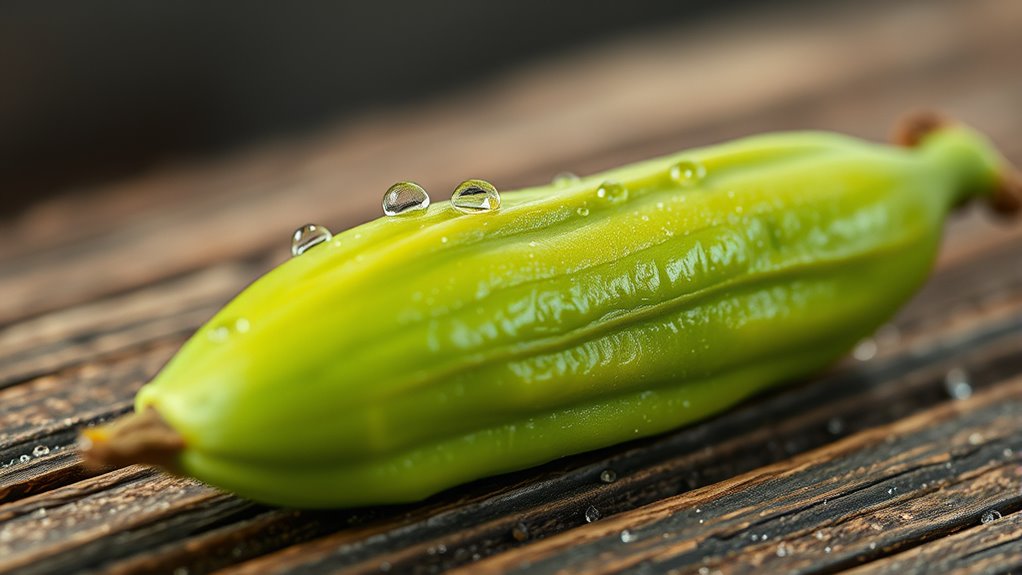Water activity (aW) measures how much free water is available in green beans for microbial growth, chemical reactions, and flavor development. Managing aW is essential because it helps prevent spoilage, extend shelf life, and preserve the beans’ desired flavor profiles. Controlling humidity, drying properly, and storing beans in airtight containers keep water activity balanced. If you stay aware of these factors, you’ll gain better control over green bean quality and aging; continue exploring to learn more.
Key Takeaways
- Water activity indicates the amount of free water in green beans, affecting microbial growth and shelf life.
- Proper management of water activity preserves flavor, aroma, and overall quality during aging.
- Monitoring water activity helps prevent spoilage caused by bacteria, molds, and yeasts.
- Controlled storage conditions (humidity, temperature) maintain optimal water activity levels for bean preservation.
- Adjusting water activity through drying and airtight storage extends green bean freshness and aging potential.
Defining Water Activity and Its Measurement
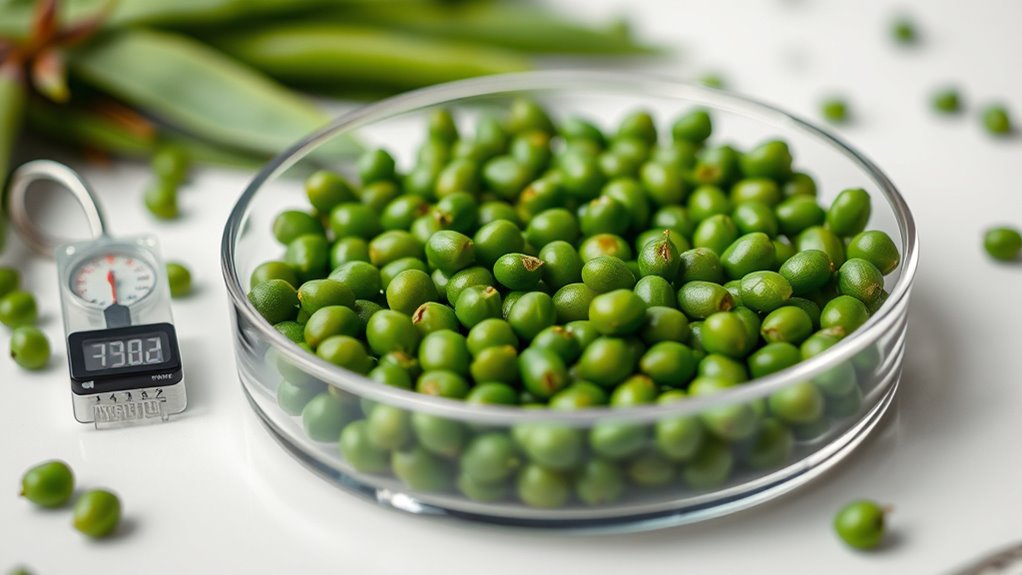
Water activity (aW) is a measure of how much free water is available in a product for microbial growth, chemical reactions, and enzymatic activity. In coffee bean roasting, understanding aW helps explain how moisture levels influence flavor profiles. During roasting, moisture loss alters the water activity, impacting the development of complex flavors. A higher aW can encourage microbial activity, but in roasted beans, it’s more about how water interacts with sugars, acids, and oils, shaping taste. Measuring aW involves using specialized instruments called water activity meters, which assess water vapor pressure in the product. Controlling water activity is essential for maintaining fresher coffee and ensuring the development of consistent flavor profiles. By controlling water activity, you can better predict how roasting and storage affect coffee quality, ensuring consistent flavor profiles and freshness in your finished brew.
The Role of Water Activity in Green Bean Preservation
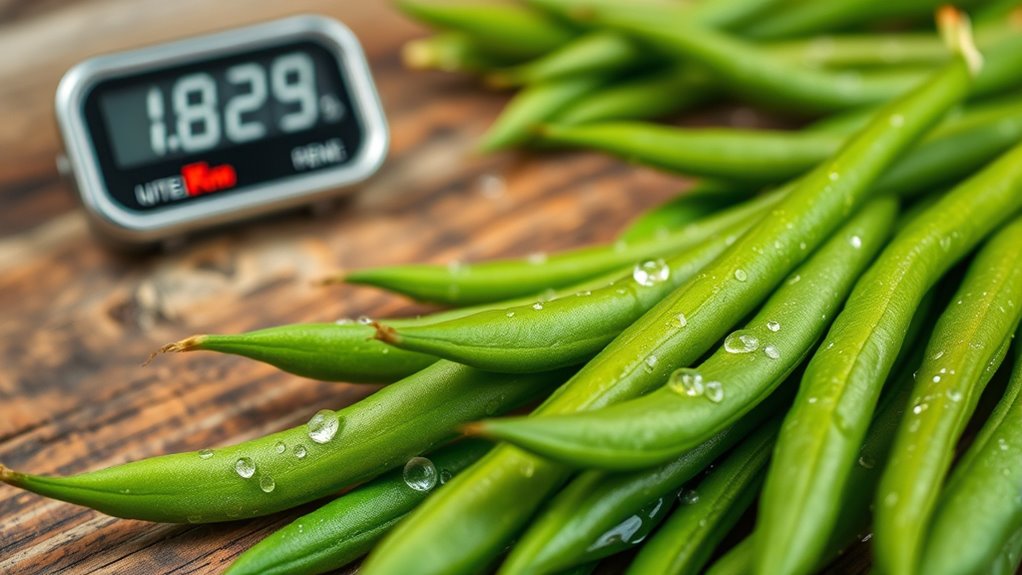
Water activity directly influences how long green beans stay fresh by controlling microbial growth. When you manage water activity levels, you also affect how flavors develop during storage. Understanding this balance helps you preserve quality and extend shelf life effectively.
Controlling Microbial Growth
Since microbial growth depends heavily on moisture availability, controlling water activity is vital for preserving green beans. When bean moisture levels are high, microbes like bacteria and mold thrive, speeding up spoilage. To slow this process, you need to manage storage humidity carefully. By keeping storage humidity low, you reduce water activity, making the environment less inviting for microbes. Proper drying techniques and airtight containers help maintain ideal water activity levels. If water activity drops too low, microbial growth stalls, extending the green beans’ shelf life. In contrast, excessively humid storage conditions increase bean moisture, promoting spoilage. Consistent control of storage humidity ensures the water activity stays within a safe range, effectively preventing microbial proliferation and preserving green bean quality over time.
Impact on Flavour Development
Have you ever wondered how the moisture level in green beans influences their flavor? Water activity affects not just preservation but also how flavors develop over time. When water activity is ideal, it enhances caffeine extraction during brewing, leading to a richer taste. Too high or low moisture levels can impact brewing temperature, altering flavor extraction and aroma. This balance influences the development of complex flavor notes and overall freshness. Proper water activity guarantees that green beans age gracefully, maintaining excellent flavor profiles.
- Caffeine extraction efficiency
- Brewing temperature stability
- Preservation of aromatic compounds
- Development of flavor complexity
How Water Activity Influences Flavor Development
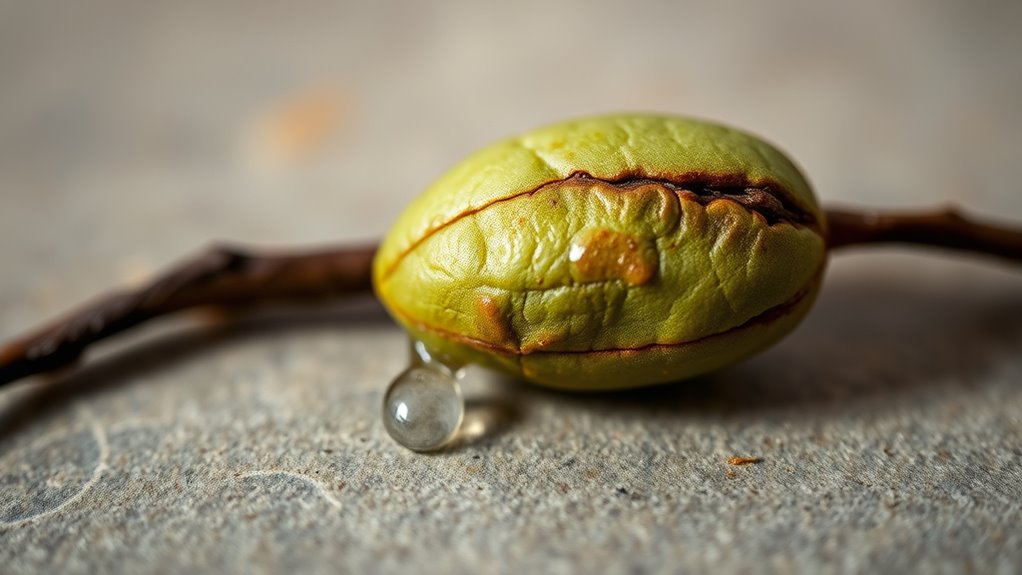
Water activity affects how flavors develop by controlling moisture levels, which influence chemical reactions in your product. When moisture is balanced properly, it enhances the extraction of flavors without encouraging spoilage. Keeping water activity in the right range also prevents microbial growth that could otherwise alter or degrade the taste. Proper moisture management may also involve understanding the safety features of your storage environment to ensure the longevity of your product.
Moisture Balance Effects
Moisture balance plays an essential role in flavor development by directly affecting water activity within food products. When moisture levels are ideal, flavor compounds interact more effectively, enhancing the bean’s unique qualities. Variations in bean varietal differences influence how water interacts with the beans, shaping aging outcomes. Sustainable farming practices often result in beans with consistent moisture content, supporting stable water activity. If moisture is too high or low, it can hinder flavor complexity or cause staling. Achieving the right moisture balance ensures that aging progresses smoothly, preserving the bean’s intrinsic flavors. Proper management of moisture levels helps maintain desirable water activity, facilitating natural flavor development and consistency across batches. Additionally, the technology used in measuring and controlling water activity is vital for optimizing aging processes and ensuring quality.
Microbial Growth Control
Controlling microbial growth is crucial for preserving flavor quality in food products, and water activity plays a critical role in this process. When you manage bean moisture and storage humidity carefully, you limit the conditions that support microbial development. Low water activity inhibits bacteria, molds, and yeasts that could spoil the beans or alter their flavor. By maintaining proper storage humidity, you prevent excess moisture buildup that could increase water activity and promote microbial growth. This helps preserve the beans’ freshness and enhances flavor development over time. Keeping water activity in an ideal range ensures that harmful microorganisms stay in check while allowing beneficial enzymatic reactions to continue. Proper control of bean moisture and storage humidity is key to aging green beans without compromising their flavor.
The Relationship Between Water Activity and Microbial Growth
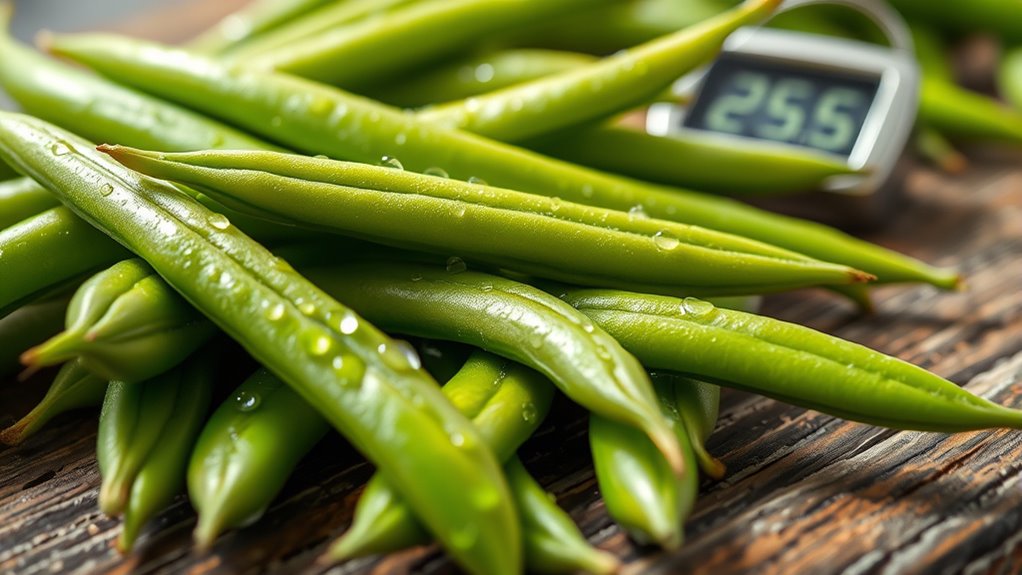
Since microbial growth depends heavily on the availability of unbound water, water activity serves as a key indicator of an environment’s potential to support microorganisms. When water activity is high, microbes thrive, impacting bean quality during storage. As moisture migrates within stored green beans, it can create localized zones of higher water activity, fostering mold or bacteria growth. Controlling water activity helps prevent spoilage and maintains bean quality over time. Kia Tuning techniques such as ECU remapping can optimize environmental conditions during storage to reduce microbial risks.
Factors That Affect Water Activity in Stored Green Beans
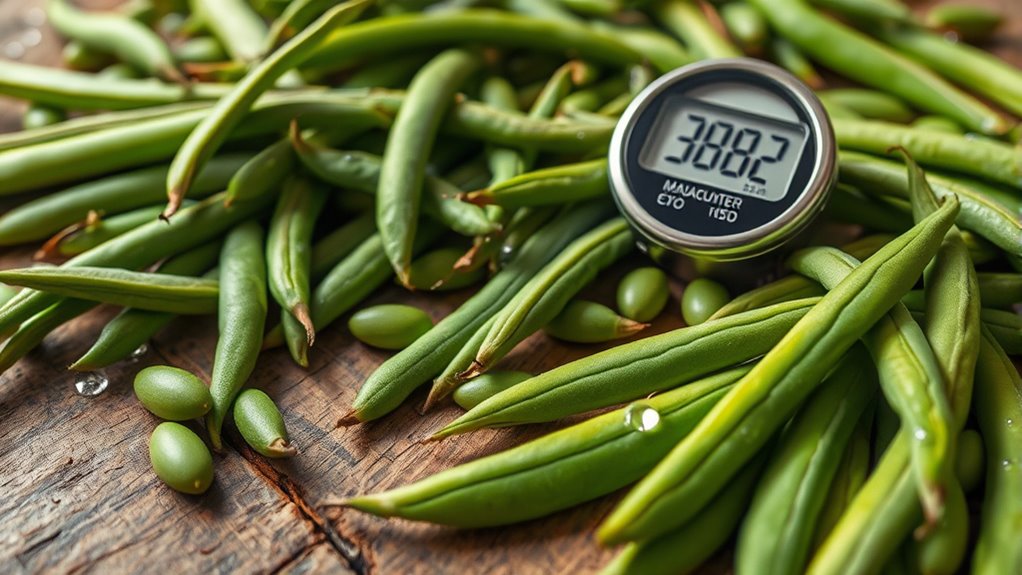
Several factors influence water activity in stored green beans, affecting their susceptibility to microbial growth and spoilage. Bean moisture levels directly impact water activity; higher moisture increases the availability of free water, promoting spoilage. Storage humidity also plays a vital role—if humidity is too high, beans absorb moisture, raising water activity and risking mold or bacterial growth. Conversely, low humidity can cause beans to lose moisture, lowering water activity and potentially leading to quality deterioration. Temperature interacts with these factors, impacting moisture retention and microbial stability. Proper storage conditions, including controlled humidity and temperature, help maintain optimal bean moisture levels, keeping water activity in a safe range. Managing these factors is essential to preserve green bean quality and prevent spoilage over time. Employing asset division strategies, such as proper documentation and understanding of regulations, can also be crucial in different contexts.
Comparing Water Activity in Fresh vs. Aged Beans
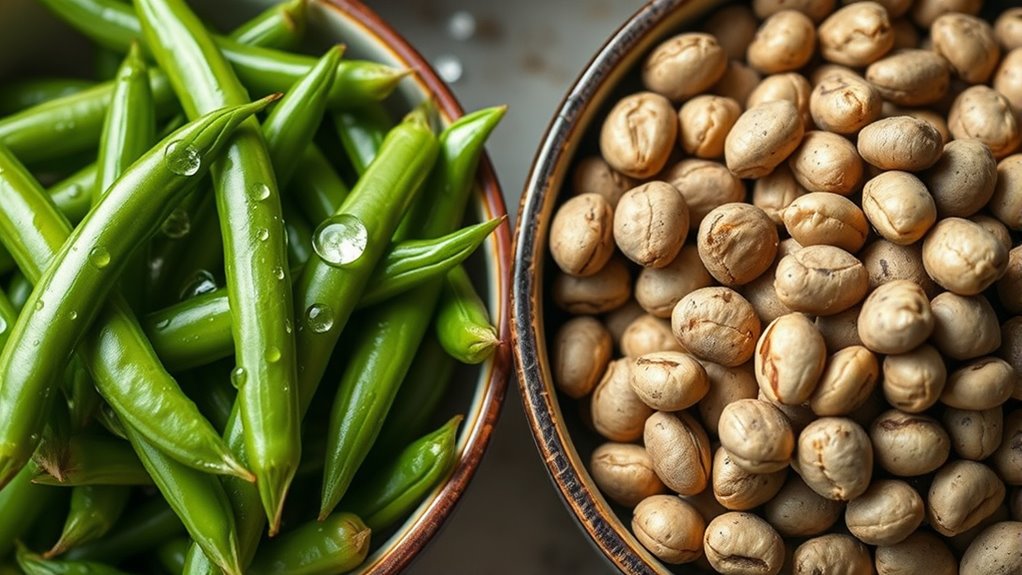
As green beans age, their water activity generally decreases, affecting their overall quality and shelf life. Fresh beans typically have higher bean moisture, allowing water diffusion to occur more freely, which maintains their freshness. Over time, aging causes moisture loss and tighter cell structures, reducing water activity. You’ll notice that aged beans are drier and less prone to spoilage. Utilizing natural materials like linen and wood in packaging can help maintain optimal moisture levels during storage. Reduced water diffusion limits microbial growth, extending shelf life. The decrease in water activity impacts texture and flavor.
Techniques for Monitoring Water Activity During Storage
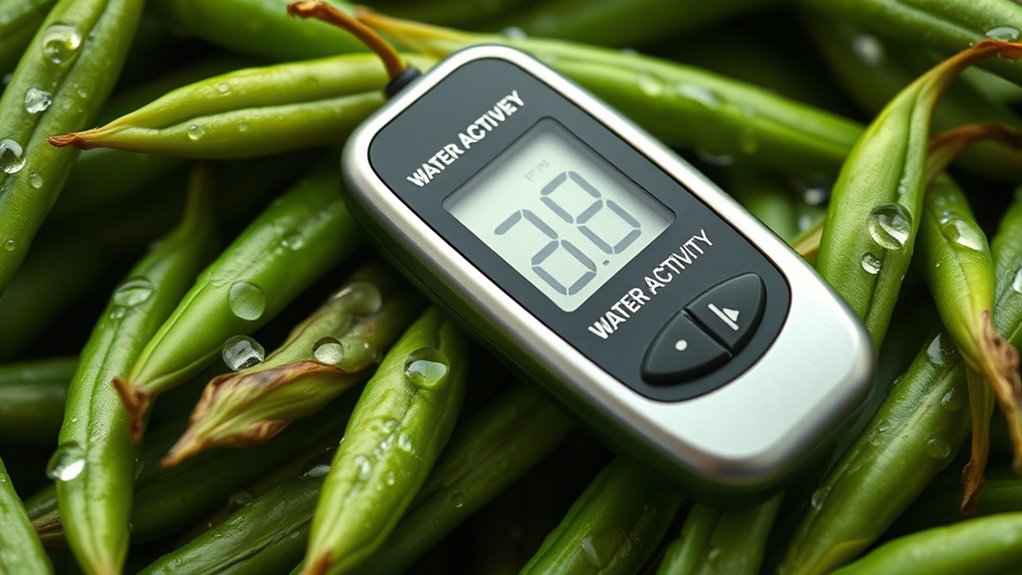
To effectively monitor water activity during storage, you need to focus on proper hygrometer placement, ensuring it accurately measures conditions without interference. Regular checks are essential to catch any fluctuations early, helping you maintain ideal storage environments. Additionally, controlling storage conditions like temperature and humidity supports consistent water activity levels and product quality.
Precise Hygrometer Placement
Achieving accurate water activity measurements depends heavily on placing the hygrometer correctly within your storage environment. Proper placement guarantees reliable data for monitoring green bean aging. To optimize precise hygrometer placement, position the device away from direct sunlight, drafts, and moisture sources, which can skew readings. Keep it at the same height and within the central area of your storage space for consistency. Regular calibration techniques are essential to maintain accuracy, so calibrate your hygrometer periodically according to the manufacturer’s instructions. Consider using multiple sensors in different zones to get a thorough view of water activity levels. This approach helps you detect uneven moisture distribution and adjust storage conditions accordingly. Understanding water activity is crucial for ensuring optimal storage conditions and prolonging the freshness of green beans.
Regular Water Activity Checks
Regularly monitoring water activity during storage is essential to guarantee beans maintain ideal moisture levels. Consistent checks help you detect any shifts that could compromise bean quality or aroma preservation. Using a calibrated water activity meter provides accurate readings, allowing you to track changes over time. It’s best to take measurements at multiple points within the storage area to identify uneven moisture distribution. Record results systematically to observe trends and address issues promptly. By maintaining precise water activity levels, you prevent mold growth, preserve the beans’ natural aroma, and sustain overall quality. Remember, small fluctuations can considerably impact aging, so routine checks are key to optimal storage conditions and ensuring your green beans remain fresh and flavorful. Proper storage conditions, including controlling water activity, are crucial for extending the shelf life and quality of your beans.
Controlled Storage Conditions
Implementing controlled storage conditions helps you maintain consistent water activity levels and prevent fluctuations that could harm your beans. Monitoring water retention is essential for managing bean hydration and avoiding conditions that promote spoilage or mold. To achieve this, consider the following techniques:
- Use hygrometers to track humidity levels precisely.
- Store beans in airtight containers to stabilize moisture.
- Regulate storage temperature to prevent unintended water loss or absorption.
- Regularly check for signs of moisture buildup or dryness.
- Incorporate water activity measurement to more accurately assess and control bean freshness.
Managing Water Activity to Extend Green Bean Shelf Life
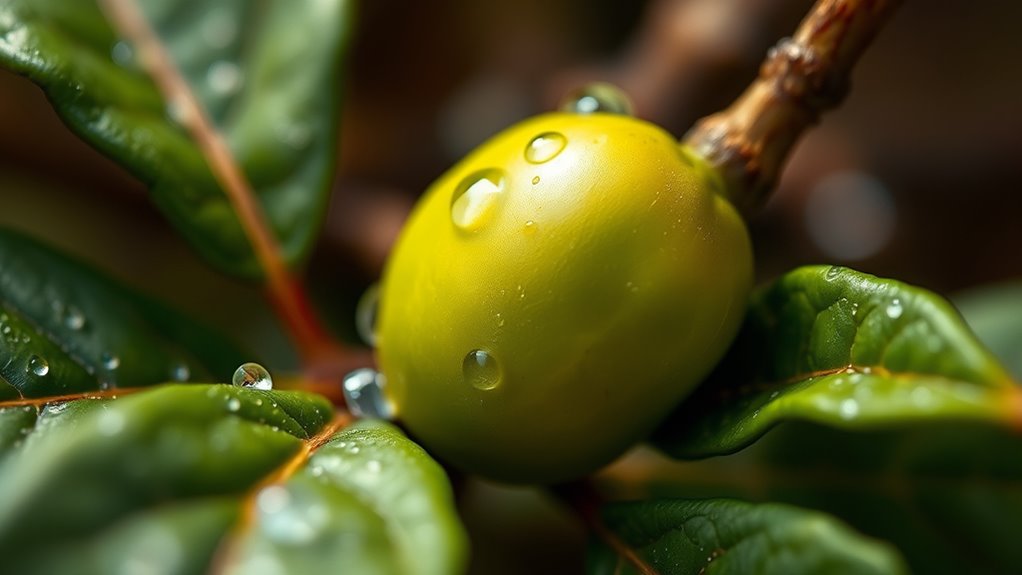
Have you ever wondered how controlling water activity can help keep green beans fresh longer? Managing water activity is key to extending shelf life by preserving green bean hydration and flavor stability. You can control water activity through proper storage, humidity control, and packaging. Imagine a table that shows different humidity levels and their effects:
| Humidity Level | Green Bean Hydration | Flavor Stability |
|---|---|---|
| Low | Dehydration | Loss of fresh flavor |
| Moderate | Ideal hydration | Maintains flavor profile |
| High | Excess moisture | Mold risk, spoilage |
| Very High | Waterlogging | Rapid deterioration |
| Very Low | Drying out | Flavor dullness |
Controlling these levels helps keep your green beans fresh, flavorful, and ready for roasting. Proper storage conditions play a vital role in managing water activity effectively.
Practical Tips for Roasters and Baristas on Controlling Water Activity
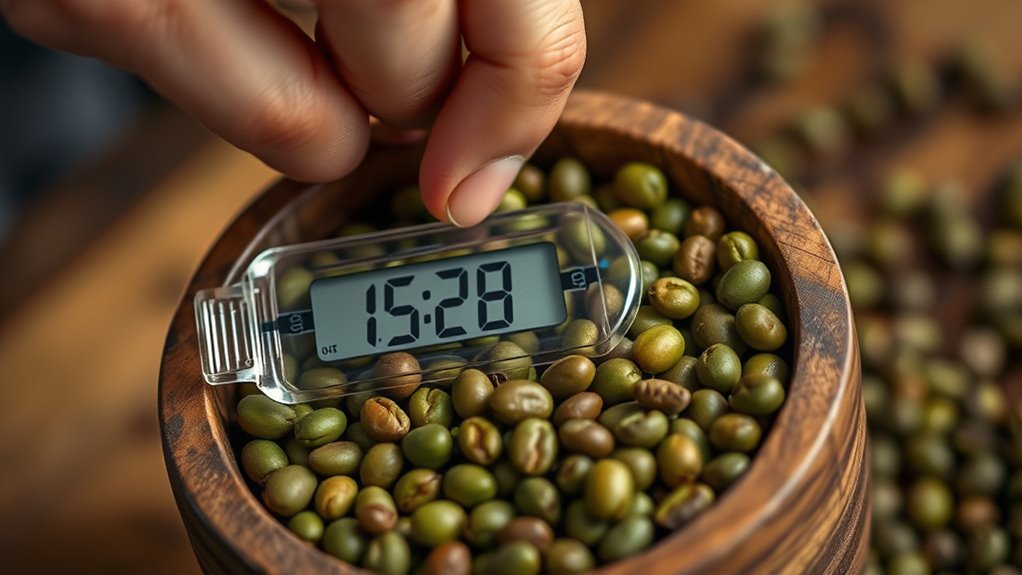
Controlling water activity is essential for roasters and baristas to preserve coffee quality and prevent spoilage. To manage this effectively, monitor bean moisture levels and adjust storage humidity accordingly. Keeping beans at ideal moisture prevents mold growth and flavor loss. Ensure storage environments are stable, avoiding fluctuations in humidity that can alter water activity. Proper handling during roasting also influences water activity, as over-roasting can reduce bean moisture unpredictably.
- Use airtight containers to regulate humidity exposure
- Store beans in cool, dry environments with consistent humidity
- Regularly check and maintain storage humidity levels
- Allow beans to rest after roasting for moisture stabilization
Future Trends and Innovations in Water Activity Management
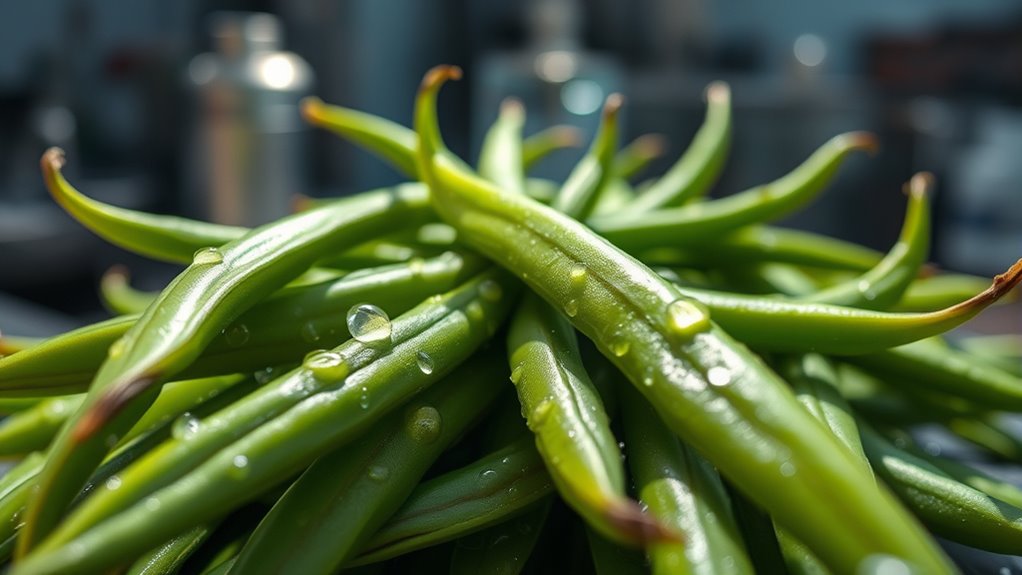
Advancements in technology are shaping the future of water activity management, offering more precise and efficient ways to preserve coffee quality. Water activity sensors are becoming more accurate, providing real-time data to optimize storage conditions. Sustainable packaging innovations, like biodegradable films and moisture barriers, help maintain ideal water activity levels while minimizing environmental impact. These trends allow you to better control aging processes, reducing spoilage and flavor loss. Imagine a future where sensors automatically adjust packaging or storage environments, ensuring consistent freshness. This integration of technology and eco-friendly materials not only elevates quality but also aligns with sustainable practices. Embracing these innovations empowers you to protect your beans more effectively, ensuring every cup delivers the perfect balance of flavor and aroma.
| Innovation | Impact |
|---|---|
| Water activity sensors | Precise monitoring for ideal conditions |
| Sustainable packaging | Eco-friendly, moisture-controlled preservation |
| Automated adjustments | Real-time responses to sensor data |
| Eco-conscious materials | Reduce environmental footprint |
| Enhanced control | Consistent bean quality and flavor retention |
Frequently Asked Questions
How Does Water Activity Affect Green Bean Aroma Preservation?
Water activity directly impacts how well you preserve green bean aroma, as it influences moisture control. When water activity is low, there’s less moisture for microbial growth and enzymatic reactions that can degrade bean aroma. By managing water activity, you help maintain the beans’ freshness and flavor, ensuring the aroma stays intact longer. Proper moisture control is key to locking in the green beans’ natural aroma and preventing premature deterioration.
Can Water Activity Levels Predict Green Bean Spoilage?
You might wonder if water activity levels can predict green bean spoilage. Lower water activity generally helps prevent microbial growth, reducing bean spoilage, but it’s not the sole factor. By controlling moisture through proper storage, you can extend freshness and minimize spoilage risks. Keep an eye on water activity to maintain ideal moisture levels, ensuring your green beans stay fresh longer and resist spoilage effectively.
What Is the Ideal Water Activity Range for Aging Green Beans?
The ideal water activity range for aging green beans is between 0.60 and 0.70. You should monitor bean moisture levels and guarantee storage conditions stay consistent, preventing excess humidity or dryness. Maintaining this water activity helps preserve flavor and texture while reducing spoilage risk. By controlling humidity and temperature, you optimize aging conditions, keeping your green beans fresh and flavorful throughout the process.
How Do Environmental Humidity and Temperature Impact Water Activity?
Think of humidity and temperature as the weather forecast for your green beans’ health. High humidity increases water activity, making beans more prone to spoilage, while low humidity dries them out. Temperature regulation helps maintain ideal water activity levels, preventing mold or shriveling. Proper humidity control and temperature regulation are essential to keep your beans aging gracefully, ensuring they develop the desired flavors and textures over time.
Are There Natural Methods to Adjust Water Activity in Green Beans?
You can naturally adjust water activity in green beans by managing their moisture levels through seed hydration techniques. To increase water activity, introduce natural moisture sources like humid environments or soaking in water, ensuring the beans absorb enough moisture. Conversely, to lower water activity, you can dry the beans using natural methods such as sun drying or air circulation. These approaches help control moisture content, optimizing aging and storage conditions.
Conclusion
So, next time you’re marveling at a perfectly aged green bean, remember—controlling water activity might be the secret to that elusive, ideal flavor. Ironically, in mastering moisture levels, you’re also mastering the art of stalling microbial chaos and preserving freshness. It’s funny how something so tiny can wield such power over taste and longevity. Embrace water activity management, and you’ll keep those beans happier—and tastier—longer than you ever thought possible.
